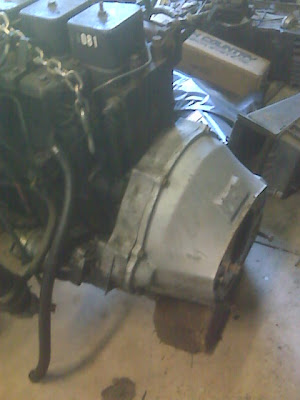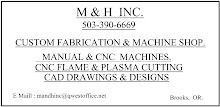 Her is the engin with frash paint. I ran out of orange before I got to the oil pan.
Her is the engin with frash paint. I ran out of orange before I got to the oil pan.Saturday, March 28, 2009
Please forgive me.
 Her is the engin with frash paint. I ran out of orange before I got to the oil pan.
Her is the engin with frash paint. I ran out of orange before I got to the oil pan.More engine teardown.
To get to the top inside nut on the power steering pump, I had to modify a 15 mm wrench. Luckily, in my toolbox I was able to find a cheap loner wrench. A few seconds with the torch, and I was able to get right back to work. (unfortunately, I left the acetelene bottle on and now it is empty. Doh!)
 My custom wrench.
My custom wrench.Dowel pin tab.
Friday, March 20, 2009
Timing cover removal.
I started by removing the dampner. The unmistakable smell of locktite, not to mention the hernia in my gut, tells me these bolts were put in to stay. (note to self: Get the four dampner bolts off the head and into a labeled bag, Dummy.)
 Having removed a cummins timing cover before, I knew there were different length bolts holding it on. Some go through the cover and case and into the block (long). Others just hold the cover to the case (short).
Having removed a cummins timing cover before, I knew there were different length bolts holding it on. Some go through the cover and case and into the block (long). Others just hold the cover to the case (short).To avoid confussion upon reassembly, I made a map of the cover. At the bottom I traced each size bolt and labeled the long bolts "1" and the short "2." I also indicated any "special" doodads different bolts, such as on extended "1" and one extended "2" that hold the factory tach pick-up.
 The first thing I checked upon removing the timing cover was the infamous killer-dowel-pin (KDP). This dowel is used by the factory to aid assenbly. Other than that its only purpose is to, perhaps, strengthen the block to case attachment. The dowel pin won its name, Killer, and its infamy from its habit of backing out of its home and taking a ride through the timing gears. Personally, I make a habit of "killing" the KDP anytime I have the timing case open or if I even have easy access, such as if the rediator is out. The KDP can be killed by either peening the aluminum case around the dowel pin hole with a punch or by fabbing a tab to cover the hole. The tab can be held in place by the case attachment bolt immediately to the right of the pin.
The first thing I checked upon removing the timing cover was the infamous killer-dowel-pin (KDP). This dowel is used by the factory to aid assenbly. Other than that its only purpose is to, perhaps, strengthen the block to case attachment. The dowel pin won its name, Killer, and its infamy from its habit of backing out of its home and taking a ride through the timing gears. Personally, I make a habit of "killing" the KDP anytime I have the timing case open or if I even have easy access, such as if the rediator is out. The KDP can be killed by either peening the aluminum case around the dowel pin hole with a punch or by fabbing a tab to cover the hole. The tab can be held in place by the case attachment bolt immediately to the right of the pin. After tapping on the pin with a punch, it went in about 3/16 of an inch. It is generally assumed that the dowel pin is bottomed out upon assembly. I do not know if this is the case, but if it is, mine was on its way out. Not knowing how many miles were on this engine, I have no way of knowing how much time before...Boom. My guess issomewhere around a million more miles. If its only gone 3/16 inch in most likely 2-300,000 miles, it was not in a hurry.
After tapping on the pin with a punch, it went in about 3/16 of an inch. It is generally assumed that the dowel pin is bottomed out upon assembly. I do not know if this is the case, but if it is, mine was on its way out. Not knowing how many miles were on this engine, I have no way of knowing how much time before...Boom. My guess issomewhere around a million more miles. If its only gone 3/16 inch in most likely 2-300,000 miles, it was not in a hurry. Another note: The last pin I killed, on my ramcharger project, some of the case bolts were loose. I mean, not even finger tight. One of these coming out will do as much damage as the dowel pin. It is also standard procedure to clean the bolts and holes and retorque them with locktite. The crank needs to be rotated to expose hidden bolts behind gears.
Another note: The last pin I killed, on my ramcharger project, some of the case bolts were loose. I mean, not even finger tight. One of these coming out will do as much damage as the dowel pin. It is also standard procedure to clean the bolts and holes and retorque them with locktite. The crank needs to be rotated to expose hidden bolts behind gears. A point of curriousity: When rotated, the timing mark "0" on the lower gear will line up with the "E" mark on the upper gear. I will head over to http://www.dieseltruckresource.com/dev/forumdisplay.php?f=93 to see if this is staight up or if it is a tooth off as I expect.
A point of curriousity: When rotated, the timing mark "0" on the lower gear will line up with the "E" mark on the upper gear. I will head over to http://www.dieseltruckresource.com/dev/forumdisplay.php?f=93 to see if this is staight up or if it is a tooth off as I expect. Friday, March 13, 2009
Nekkid Engine
Thursday, March 12, 2009
Engine on the stand.
 Left side.
Left side.Wednesday, March 11, 2009
Wow, middle of June to middle of March. Seriously, where have I been.

Since the engine was sitting on blocks on the floor, and one of the blocks was under the bell, I lifted the engine with the cherry picker.

A shot of the inside of the bell housing with the clutch fork and throw-out bearing set in place.

A shot of the pressure plate on the back of the engine.

A peek at the fingers on the pressure plate.

"LUK" is stamped into the pressure plate. I mainly want to post this and some of the following pics so I can link to them when I ask some qustions over at dieseltruckresource.com and or ramchargercentral.com.

12 1/4 inches.

Not dead, but not enough to put back on. Looks like I am buying a new clutch.


More numbers. These are on the flywheel.

Inside of the pressure plate.

Flywheel on the floor.

Flywheel number.

Flywheel number.

More flywheel info.

Here is a shot of the adapter plate that attaches the 1993 engine to the NV4500 that did not come out in the dodges until 1994.

A bit blurry shot of the end of the crank and the back of the block. Finally a mounting surface for the engine stand.

I may regret it later, but I left the starter on the adapter plate. I di not have a metrick 12 point socket to remove the starter bolts. Sniff. I smell tool purchase in the near future.



 Right again.
Right again.
 Yep.
Yep.






 For some reason the oil pan and timing cover are Cummins beige. I wish I knew the history on this thing.
For some reason the oil pan and timing cover are Cummins beige. I wish I knew the history on this thing. Somebodies mod on the throttle linkeage
Somebodies mod on the throttle linkeage

 There is about 3/4 inch between the top of the pump and the head.
There is about 3/4 inch between the top of the pump and the head. Another mystery. The info plate is missing from the side of the timing case.
Another mystery. The info plate is missing from the side of the timing case.




